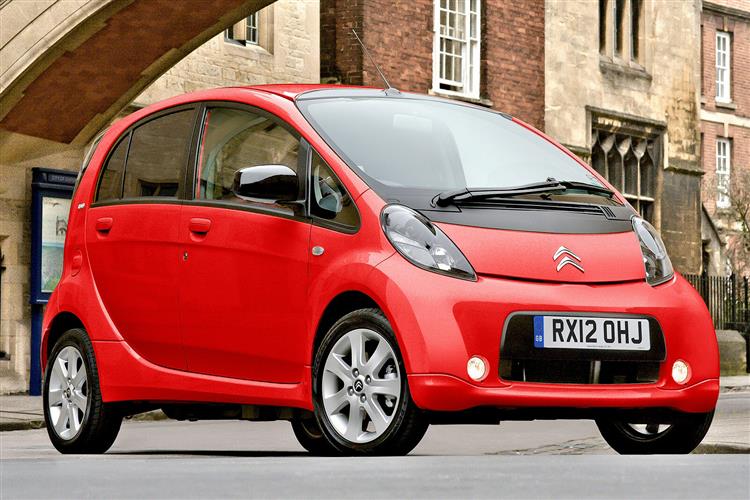SMOKE ZERO (some text hidden) --NONE--
By Jonathan Crouch
Introductionword count: 72
Citroen's C-ZERO was one of the very earliest full-electric small cars, launched back in 2010 and sold over ten years until more sophisticated full-electric battery small hatches arrived on the market. The C-ZERO might not be the most adventurous all-electric vehicle you've ever seen, but it's an affordable and potentially sensible choice if all you need a little BEV model for is very short hops. You'll need to buy very carefully though.
Modelsword count: 4
5dr Supermini (BEV [47,64,67KW])
Historyword count: 286
Zero. Zilch. Nothing. When it comes to the future of fuelling our cars, that's the figure we're all aiming at. A pipe dream? Maybe not, according at least to Citroen back in 2010 when they first introduced this car, the all-electric C-ZERO. For over seventy years, the French brand has been one of the pioneering forces behind the development of automotive electric power, a period in which, prior to the launch of this BEV, they had sold over 10,000 battery-powered vehicles. It was only following the turn of the century however, that the lithium-ion battery technology we've all benefitted from in our laptops and mobile 'phones was able to open up the possibility of such cars becoming a realistic alternative to conventional petrol or diesel models. Which enabled Citroen, working alongside Mitsubishi and its PSA group partner Peugeot, to bring this C-ZERO model to market. We're talking here about a proper car, not a safety legislation-dodging 'quadricycle' like some of the less savoury electric vehicles that appeared on the market in the early Noughties. A little family runabout you could use every day, almost without noticing it ran on battery power. That's something that in the 21st Century's first decade, almost every major car maker talked about but Citroen was one of the very few who actually got on and brought such a thing to market. This C-ZERO model was part of a joint development programme which also bought us Mitsubishi's MiEV and Peugeot's iON, all essentially based on the same design. The C-ZERO started out in 47KW form, but was later upgraded with a 64 or 67KW powerplant. It sold until 2020. So how does it stack up as a used buy? Let's find out.
What You Getword count: 447
This C-ZERO certainly won't put off any prospective buyers with its very conventional looks. It's clearly a little sub-supermini citycar, if a rather high-sided one. At 3.5m in length, it's more akin to Citroen's C1 in size than the company's C3 supermini, though the 1.6m height makes it feel pretty big inside. If you find that high-sided look very Japanese, you're absolutely right. This is essentially a Mitsubishi, Citroen and their PSA group partners Peugeot having turned to the Oriental brand for help in sharing the massive development costs of this car. The Japanese maker was looking for development shortcuts too, basing this model on its Mitsubishi i, a conventionally powered city runabout with a design dating back to before 2007. Having to base this thing on a little citycar wasn't ideal for Citroen. Whereas in this era, rivals Nissan could point to a relatively small price gap between a top-spec diesel Focus-sized family hatchback and their comparably-sized all-electric LEAF model, the French maker acknowledged that there was a yawning price differential between the cost of an urban runabout like their C1 and this C-ZERO. But they did point out that within the confines of its compact dimensions, this car offers a surprising amount of space inside. True enough, it does feel surprisingly airy inside. Certainly the cabin is narrow as it has to be given that the car is under 1.6m wide but unless you're trying to transport a trio of rugby players, you shouldn't feel it too much. At the wheel where you sit rather higher than some drivers might like, you shouldn't expect especially high standards of fit and finish. Still, the Japanese production line screwed everything together pretty well and ergonomically, the layout is sound, with excellent all-round visibility. Taking a seat here for the first time, the only clue most would have that this was not conventional petrol powered citycar would be the fact that the dash displays a petrol pump with, somewhat oddly, an electric plug hanging out of it. Is that better or worse than using a mobile phone when topping up? We're not sure. As for rear seat room, well thanks to the fact that the propulsion system is very compact and the underfloor batteries don't impinge too much on cabin space, there's enough space for two adults - or even three children - to feel quite comfortable on the kind of short to medium journeys this car will be making. Boot space is pretty limited though, with just 166-litres below the parcel shelf. Of course though, if you're not using the back seat, you can push forward the 50/50 split-folding rear seats to free up much more space.
To see the full road test text contact us on 0330 0020 227
Pictures (high res disabled)

.jpg)
|
.jpg)
|
.jpg)
| |||
.jpg)
|
.jpg)
|
.jpg)
|
Scoring (subset of scores)
Category: Hybrid, Plug-in, Electric & Hydrogen
| Performance | |
| Handling | |
| Comfort | |
| Space | |
| Styling, Build, Value, Equipment, Depreciation, Handling, Insurance and Total scores are available with our full data feed. | |



